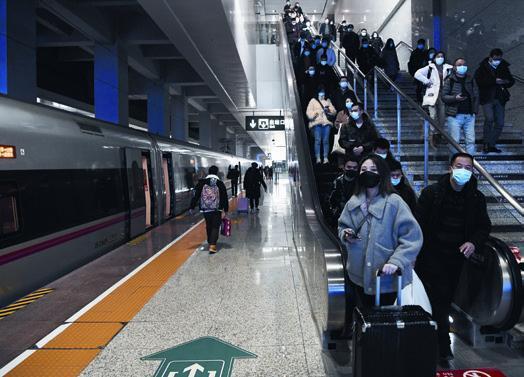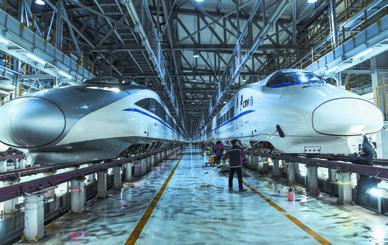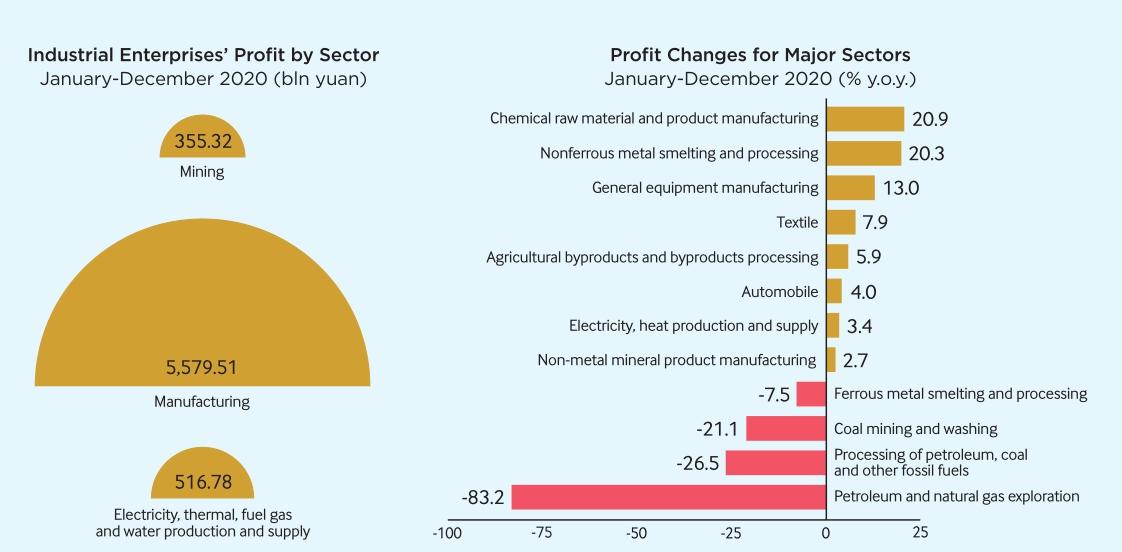THE WAY HOME

Passengers at a railway station in Chongqing on January 28, the day the Spring Festival travel season began. The 40-day period is expected to see 1.7 billion passenger trips. The number, though projected to rise 10 percent year on year, is also expected to be 40 percent less than in 2019 as new measures reduced mass gatherings to strengthen novel coronavirus disease control. The journeys are for families to meet and celebrate the Lunar New Year, which falls on February 12 this year.
Fully Prepared
High-speed trains receive a thorough cleaning in Guiyang, capital of Guizhou Province in southwest China, on January 26, to prepare for the 40-day Spring Festival travel rush from January 28.Security System
China had included 253,000 unsupported children, whose parents are unable to care for them, in a special security system by late 2020, an official with the Ministry of Civil Affairs said on January 25.A monthly subsistence allowance of 1,140 yuan ($176) is provided per child, the same as that provided to an orphan, Ni Chunxia, Deputy Director of the ministrys child welfare department, said at a press conference.
Ni clearly defined the “unsupported child” classification.
Children are considered unsupported if their parents are both seriously disabled, gravely ill, in prison, in drug rehabilitation, missing or subject to other measures restricting their personal freedom, if they have had their guardianship revoked or have been repatriated (expelled) from the country, or where one parent is dead or missing and the other parent falls into one of the eight outlined categories.
Statistics show that 45.1 percent of the 253,000 unsupported children are those with one parent dead and the other missing, severely disabled or in one of the other circumstances mentioned, according to Ni. Children whose parents are both seriously disabled account for 27.4 percent, and those whose parents are in prison, 8.3 percent.
In terms of regional distribution, 85 percent of unsupported children are rural residents.
Industrial Upgrades
The National Development and Reform Commission released a revised catalog of industries whose development is to be encouraged in the western region on January 26.The move aims to promote industrial upgrades and the development of characteristic industries across the vast western areas.
Effective from March 1, the revised catalog will enable eligible enterprises to have their corporate income tax reduced by 15 percent.
Industries including automobile and parts production, smart and green textile, garment processing, as well as household appliances and consumer electronics manufacturing have been added to the list, the commission said.
To push the western provinces to better employ their unique advantages, industries such as agriculture, forestry, husbandry and fishery, health and tourism are also featured in the newly drafted catalog.
Businesses revolving around energy conservation, environmental protection and livable construction have been incorporated, along with light industrial textiles, special handicrafts, and other industries that promote employment and boost residents incomes.
The enterprises eligible for preferential tax policies are those whose main business is in the aforementioned industries, and those whose core business income accounts for more than 60 percent of their total revenue.
Drought Monitoring
As of January 26, over 475,333 hectares of arable land had been affected by drought, with some 170,000 villagers having difficulty in accessing clean drinking water, according to data from the Ministry of Water Resources.Several cities and counties across Zhejiang, Guangdong and Yunnan provinces recently were faced with a tight water supply, affecting around 1.4 million people, the ministry said.
Parts of south China will likely continue to see water shortages, partly due to less rainfall and inadequate reservoir water storage.
Local authorities should closely monitor any further drought developments, speed up the construction of emergency water projects, and ensure safe drinking water for all residents.
The ministry has dispatched three teams to Zhejiang, Guangxi, and Yunnan to help with drought relief.
Gambling Blacklist
A few more overseas destinations will be added to Chinas blacklist for cross-border gambling tourist destinations, the Ministry of Culture and Tourism (MCT)announced on January 26.
The ministry, in conjunction with relevant departments, will draft a list of the second batch of overseas destinations attracting Chinese tourists for gambling purposes, which will be subsequently added to the system, the ministry noted.
In order to better regulate the tourism market and safeguard the lives and properties of Chinese citizens, the blacklist system was established through the concerted efforts of multiple departments, including the MCT, the Ministry of Foreign Affairs and the Ministry of Public Security.
The year 2020 marked the completion of the 13th Five-Year Plan (2016-20) period and the mission to end absolute poverty in China.
Welcoming Spring Festival
Workers of a textile factory in Huzhou, Zhejiang Province in east China, make dumplings on January 26. The local government has organized cultural activities for those choosing not to return to their hometowns for the festival.High Expectations
The International Monetary Fund (IMF) on January 26 projected that Chinas economy will grow 8.1 percent in 2021, 0.1 percentage point below the forecast in October 2020, according to the latest revision of its World Economic Outlook(WEO) report.China is one of those economies that bounced back to their pre-pandemic projected level in the fourth quarter of 2020, “well ahead of” other major economies, IMF Chief Economist Gita Gopinath said at a virtual press briefing.
“China has been very successful in containing the pandemic and that has played a very important role in restoring activity much more quickly,” Gopinath said. “Theres been effective support both in terms of fiscal and monetary policies.”
Echoing Gopinaths remarks, Malhar Nabar, division chief with the IMFs Research Department, told reporters that Chinas policy support has been “a big driver”of its “impressive rebound” in 2020.
The support in terms of public infrastructure expenditure, and also the funding that was extended to affected households and to businesses, reinforced by aggressive actions by the Peoples Bank of China to provide liquidity support and ensure that credit provision remained strong, Nabar said.
“Going forward, we see a gradual handoff to private sector activity, starting out with a pickup in private investment activity,”he said. “Thats in fact already been noted in the second half of last year, and we expect that to continue.”
Nabar added that to secure the recovery path, it is “of vital importance” for China to ensure the rebalancing toward private consumption continues and “perhaps even is accelerated to an extent, with efforts to strengthen the social safety net.”
According to the latest WEO update, China will grow 5.6 percent by 2022, while the global economy is expected to expand 4.2 percent.
The IMF also revised up its forecast for the global economic growth in 2021 to 5.5 percent, up 0.3 percentage point from the projection in October 2020.
Capital Bonds
The Peoples Bank of China, the central bank, has authorized two local lenders to issue equityconversion capital bonds in the interbank bond market to replenish capital, it said in a statement on January 25.On January 20, Ningbo Commerce Bank in Zhejiang issued such bonds with no fixed maturity worth 500 million yuan($77 million).
Zhejiang Chou Zhou Commercial Bank in the same province has also obtained approval for the issuance of this kind of bond.
Holders of the bonds will be able to convert debt into stock and participate in the distribution of the issuers remaining assets if specific risk events arise. It is a tool forged to help the undercapitalized smaller banks.
Financial regulators will encourage qualified small and medium-sized banks to issue such bonds to replenish capital and bolster their capabilities to serve the real economy and defuse risks, the statement said.
New GDP Giants
Six more cities crossed the landmark of annual GDP of 1 trillion yuan ($154.8 billion) in 2020, local governments said.Hefei, capital of Anhui Province in east China, reported its GDP sat at nearly 1.0046 tril-lion yuan ($155 billion) in 2020, an annual increase of 4.3 percent, the municipal government said on January 26.
That very day, Jinan, capital of Shandong Province in the east, announced its GDP grew 4.9 percent year on year to reach nearly 1.0141 trillion yuan ($157 billion) last year.
Earlier, Nantong in Jiangsu Province in the east, Quanzhou and Fuzhou in Fujian Province in the southeast, and Xian in Shaanxi Province in the northwest all reported their annual economic aggregate exceeded 1 trillion yuan last year, raising the total number of Chinese cities in the club to 23.
Eight of these cities are in the Yangtze River Delta region, including Shanghai and the provinces of Jiangsu, Zhejiang, and Anhui.
Shanghai became the first city to hit an annual GDP of 1 trillion yuan on the Chinese mainland in 2006. In 2020, its GDP was 3.87 trillion yuan($596.3 billion).
Beijings GDP topped 3.6 trillion yuan ($554.7 billion) last year.
NUMBERS


5G Empowerment
The 5G industry will receive a boost in 2021 from improvements in the capacity of overall network coverage, application innovation and industrial support, according to the Ministry of Industry and Information Technology.With ever-increasing investment, Chinas 5G commercial development made solid strides forward last year, Zhao Zhiguo, Director of the Cybersecurity Management Bureau of the ministry, said at a press conference on January 26.
By 2020, 5G network had covered all cities above the prefecture-level, with more than 200 million 5G terminal connections and over 1,100 5G Plus Industrial Internet projects, he added.
China will build more than 600,000 5G base stations in 2021, promoting 5G coverage across a wider range and more levels, Zhao said.
The country will foster emerging consumption models such as 5G Plus VR/AR and immersive gaming as well as promote the integration of 5G technology into services including healthcare, elderly care and housekeeping.
Programs will also be launched to carry out 5G millimeter wave tests, speed up the research and development of key technologies, shore up the weak links and ensure the safety of the industrial and supply chains, Zhao said.
Roots in China
Multinational chemical company LyondellBasell and Chinas largest oil refiner, China Petrochemical Corp. (Sinopec), will set up a 50-50 joint venture, according to an agreement signed on January 26.The company will build a plant in the city of Ningbo, Zhejiang Province in east China, by the end of this year, with an annual output of 275,000 tons of propylene oxide and 600,000 tons of styrene monomer.
The demand for propylene oxide and styrene monomer in China will increase against the backdrop of its sustained economic growth, according to Torkel Rhenman, Executive Vice President of LyondellBasell.
With expanding investment across China, LyondellBasell now runs five wholly owned factories in the cities of Suzhou and Changshu in the Jiangsu Province in east China, Dongguan and Guangzhou in Guangdong Province in the south, and Dalian in Liaoning Province in the northeast.

